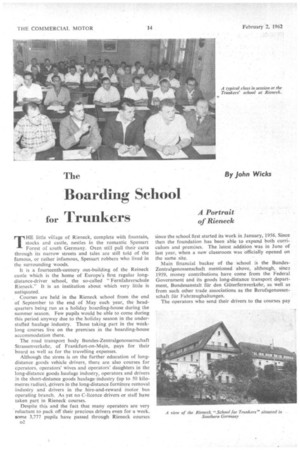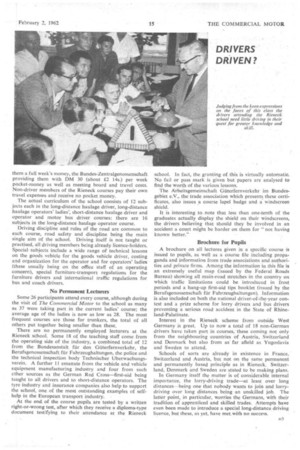The
Page 56

Page 57

If you've noticed an error in this article please click here to report it so we can fix it.
Boarding School
for Trunk ers
By John Wicks
THE little village of Rieneck, complete with fountain, stocks and castle, nestles in the romantic Spessart Forest of south Germany. Oxen still pull their carts through its narrow streets and tales are still told of the famous, or rather infamous, Spessart robbers who lived in the surrounding woods.
It is a fourteenth-century out-building of the Reineck castle which is the home of Europe's first regular longdistance-driver school, the so-called " Fernfahrerschule Rieneck." It is an institution about which very little is antiquated.
. Courses are held in the Rieneck school from the end of September to the end of May each year, the headquarters being run as a holiday boarding-house during the summer season. Few pupils would be able to come during this period anyway due to the holiday season in the understaffed haulage industry. Those taking part in the weeklong courses live on the premises in the boarding-house accommodation there.
The road transport body Bundes-Zentralgenossenschaft Strassenverkehr, of Frankfurt-on-Main, pays for their board as well as for the travelling expenses.
Although the stress is on the further education of longdistance goods vehicle drivers, there are also courses for operators, operators' wives and operators' daughters in the long-distance goods haulage industry, operators and drivers in the short-distance goods haulage industry (up to 50 kilometres radius), drivers in the long-distance furniture removal industry and drivers in the hire-and-reward motor bus operating branch. As yet no C-licence drivers or staff have taken part in Rieneck courses.
Despite this and the fact that many operators are very reluctant to pack off their precious drivers even for a week, some 3,777 pupils have passed through Rieneck courses ol since the school first started its work in January, 1956. Since then the foundation has been able to expand both curriculum and premises. The latest addition was in June of last year, when a new classroom was officially opened on the same site.
Main financial backer of the school is the BundesZentralgenossenschaft mentioned above, although, since 1959, money contributions have come from the Federal Government and its goods long-distance transport department, Bundesanstalt fur den Gfiterfernverkehr, as well as from such other trade associations as the Berufsgenossenschaft ftir Fahrzeughaltungen.
The operators who send their drivers to the courses pay
them a full week's money, the Bundes-Zentralgenossenschaft providing them with DM 30 (about L2 14s.) per week pocket-money as well as meeting board and travel costs. Non-driver members of the Rieneck courses pay their own travel expenses and receive no pocket money.
The actual curriculum of the school consists of 12 subjects each in the long-distance haulage driver, long-distance haulage operators' ladies', short-distance haulage driver and operator and motor bus driver courses: there are 16 subjects in the long-distance haulage operator course.
Driving discipline and rules of the road are common to each course, road safety and discipline being the main single aim of the school. Driving itself is not taught or practised, all driving members being already licence-holders. Special subjects include a wide range of technical lessons on the goods vehicle for the goods vehicle driver, costing and organization for the operator and for operators' ladies (these usually being on the office staff of an operating concern), special furniture-transport regulations for the furniture drivers and international traffic regulations for bus and coach drivers.
No Permanent Lecturers Some 26 participants attend every course, although during the visit of The Commercial Motor to the school as many as 37 were taking part in the current ladies' course; the average age of the ladies is now as low as 28. The most frequent courses are those for trunkers, the total of all others put together being smaller than these.
There are no permanently employed lecturers at the Rieneck school. Some 18 of the teaching staff come from the operating side of the industry, a combined total of 12 from the Bundesanstalt far den Gtiterfernverkehr, the Berufsgenossenschaft fiir Fahrzeughaltungen, the police and the technical inspection body Technischer Uberwachungsverein. A further 11 emanate from the vehicle and vehicle equipment manufacturing industry and four from such other sources as the German Red Cross—first-aid being taught to all drivers and to short-distance operators. The tyre industry and insurance companies also help to support the school, one of the most outstanding examples of selfhelp in the European transport industry.
At the end, of the course pupils are tested by a written right-or-wrong test, after which they receive a diploma-type document testifying to their attendance at the Rieneck school. In fact, the granting of this is virtually automatic. No fail or pass mark is given but papers are analysed to find the worth of the various lessons.
The Arbeitsgemeinschaft Giiterfernverkehr im Bundesgebiet e.V., the trade association which presents these certificates, also issues a course lapel badge and a windscreen shield.
It is interesting to note that less than one-tenth of the graduates actually display the shield on their windscreens, the drivers believing that should they be involved in an accident a court might be harder on them for "not having known better."
Brochure or Pupils
A brochure on all lectures given in a specific course is issued to pupils, as well as a course file including propaganda and information from trade associations and authorities and private firms. Among the information in this file is an extremely useful map (issued by the Federal Roads Bureau) showing all main-road stretches-in the country on which traffic limitations could be introduced in frost periods and a hang-up first-aid tips booklet (issued by the Berufsgenossenschaft fur Fahrzeughaltungen).. Information is also included on both the national driver-of-the-year contest and a prize scheme for lorry drivers and bus drivers preventing a serious road accident in the State of Rhineland-Palatinate.
Interest in the Rieneck scheme from outside West Germany is great. Up to now a total of 18 non-German drivers have taken part in courses, these coming not only from the neighbouring countries of Austria, Switzerland and Denmark but also from as far afield as Yugoslavia and Sweden to attend.
Schools of sorts are already in existence in France, Switzerland and Austria, but not on the same permanent and permanently based principle as in Rieneck. Switzerland, Denmark and Sweden are stated to be making plans.
In Germany itself the matter is of considerable internal importance, the lorry-driving trade—at least over long distances—being one that nobody wants to join and lorrydriving over long distances being an unskilled job. The latter point, in particular, worries the Germans, with their tradition of apprenticed and skilled trades. Attempts have even been made to introduce a special long-distance driving licence, but these, as yet, have met.with no success.




























































































































